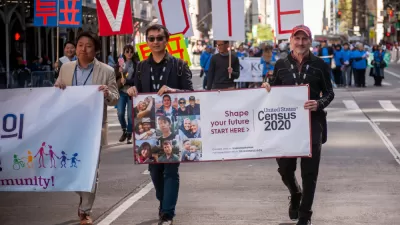Delayed operations and recommendations for how college students should report their living conditions are key to the Census response to COVID-19 so far. The Census is still expected to wrap up by the end of July 2020.

Eleven million U.S. households have responded to the 2020 Census questionnaire already, just a week after invitations started arriving in mailboxes around the country, but the spread of the novel coronavirus has completely disrupted planned operations in the same amount of time.
Just last week, the U.S. Census Bureau was proceeding as planned, with door-to-door follow ups on college campuses and other group living arrangements scheduled for April. That schedule no longer applies, though the Census Bureau hasn't yet delayed the conclusion of the 2020 Census.
A March 18 press release from the Census Bureau announced that Census field operations would be suspended until April 1, and all Census operations outside the 2020 Census would now be conducted by phone instead of in-person visits.
The Census Bureau on March 15 announced adaptations to the Group Quarters Operation of the 2020 Census plan, delaying both the Mobile Questionnaire Assistance program and the Early Nonresponse Followup operation. The Census Bureau also announced changes to its paid media campaign, earned media efforts, and partnership outreach efforts, “to adapt to changing conditions while continuing to promote self-response.” According to the March 15 press release: “The key message right now for anyone with questions about how COVID-19 will affect the 2020 Census: It has never been easier to respond on your own, whether online, over the phone or by mail—all without having to meet a census taker.”
The Census is asking college students who returned home after college campuses closed to respond with their normal living locations (i.e., their dorms, not their parents’ or guardians’ homes). The Census also promises to work with administrators in other group living arrangements to ensure accurate counts while protecting the health and safety of residents and Census workers.
The national media has also begun to track the progress of the Census Bureau in adapting to the public health concerns of the pandemic, but the news is definitely not promising for the full and scheduled completing of the 2020 Census. CNN reported this week on the low number of temporary workers currently employed by the Census:
As of February 29, the Census Bureau was paying 23,610 temporary workers. At around this time in 2010, it had about 145,000 temporary workers. While the 2020 Census plans to hire fewer than half the 1.2 million workers it needed in 2010, non-profit groups that help recruit workers for the census tell CNN the current pace of hiring suggests a bigger problem may be at play.
The Associated Press also reported on the changes to 2020 Census operations, as did the Pew Research Center. Rick Exner, writing for Cleveland.com headlined coverage of the pandemic Census with the headline “How to avoid a census worker coming to your door during coronavirus crisis.” The simple answer: “fill out your census form promptly online, by phone or through the mail.”
While field operations are suspended for the next few weeks, the Census Bureau "will continue to evaluate all 2020 Census operations," and the July 31 expected completion date could still be adjusted.

Planetizen Federal Action Tracker
A weekly monitor of how Trump’s orders and actions are impacting planners and planning in America.

Maui's Vacation Rental Debate Turns Ugly
Verbal attacks, misinformation campaigns and fistfights plague a high-stakes debate to convert thousands of vacation rentals into long-term housing.

Restaurant Patios Were a Pandemic Win — Why Were They so Hard to Keep?
Social distancing requirements and changes in travel patterns prompted cities to pilot new uses for street and sidewalk space. Then it got complicated.

In California Battle of Housing vs. Environment, Housing Just Won
A new state law significantly limits the power of CEQA, an environmental review law that served as a powerful tool for blocking new development.

Boulder Eliminates Parking Minimums Citywide
Officials estimate the cost of building a single underground parking space at up to $100,000.

Orange County, Florida Adopts Largest US “Sprawl Repair” Code
The ‘Orange Code’ seeks to rectify decades of sprawl-inducing, car-oriented development.
Urban Design for Planners 1: Software Tools
This six-course series explores essential urban design concepts using open source software and equips planners with the tools they need to participate fully in the urban design process.
Planning for Universal Design
Learn the tools for implementing Universal Design in planning regulations.
Heyer Gruel & Associates PA
JM Goldson LLC
Custer County Colorado
City of Camden Redevelopment Agency
City of Astoria
Transportation Research & Education Center (TREC) at Portland State University
Jefferson Parish Government
Camden Redevelopment Agency
City of Claremont




























